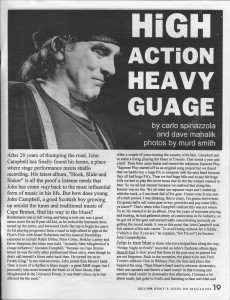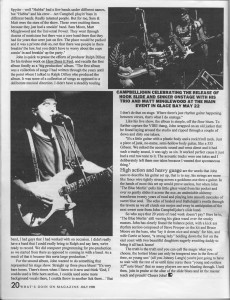by Carlo Spinazzola and Dave Mahalik
 After 20 years of thumping the road, John Campbell has finally found his home, a place where stage performance meets studio recording. His latest album, “Hook, Slide and Sinker” is all the proof a listener needs that John has come way back to the most influential form of music in his life. But how does young John Campbell, a good Scottish boy growing up amidst the tunes and traditional music of Cape Breton, find his way to the blues?
After 20 years of thumping the road, John Campbell has finally found his home, a place where stage performance meets studio recording. His latest album, “Hook, Slide and Sinker” is all the proof a listener needs that John has come way back to the most influential form of music in his life. But how does young John Campbell, a good Scottish boy growing up amidst the tunes and traditional music of Cape Breton, find his way to the blues?
Beatlemania was in full swing and being a rock star was a good career move for an 8 year old kid, so he locked the basement door, turned up the stereo, and borrowed Dad’s flat top to begin his quest. As his playing progressed from a band in high school to gigs at the Flyer’s Club with Stuart Robertson and his musical friendships expanded to include Ralph Dillon, Peter Cotter, Berkley Lamey and Enver Sampson, the blues took hold.
“Actually Matt Minglewood is a huge influence,” recounts Campbell, “because on Cape Breton Island he was the only other professional blues artist, even though he didn’t call himself a blues artist back then. He turned me on to Freddy King.” In the mid-seventies, John joined Sam Moon’s band. “Sam is more of a rhythm ‘n blues singer – a great R&B singer, but I personally lean more towards the blues so of Sam Moon, Matt Minglewood & the Universal Power, it was Matt’s blues style that affected me the most.”
After a couple of years touring the country with Sam, Campbell quit to make a living playing the blues in Toronto. That lasted a year and a half. Then John came home and started the infamous Squeeze Play.
“Squeeze Play started off as an original song project but we found that we hadda buy a huge PA to compete with the next band because they all had huge PA’s. Then we had huge bills and to pay the huge bills we had to play the cover tunes that all the bar owners wanted to hear. So we all lost interest because we realized that doing this forever was no fun. We all went our separate ways and I ended up with the truck, a 5 ton truck full of PA gear. Career-wise it was sort of a dark period. I was thinking, this is crazy, I’m gonna starve here. I’m gonna hafta sell some gear to buy groceries and pay some bills, ya know?” That’s when John Campbell realized this was not where it’s at. He wanted to do an album. Over the years of incessant playing and touring, he had gathered plenty of connections in the industry, so he got rid of the gear and started really concentrating seriously on getting the record made. It was at this point that John Campbell took full control of his solo career. To avoid being mistook for a fiddler, (“which is fine if you are,” he explains, “but I’m not”) he became John Campbelljohn.
John is true blue to those who have helped him along the way. “Friday Night At Fred’s” recorded on John’s freshman album How Does It Feel is clear proof that those in his past may be passed but are not forgotten. Back in the seventies, the place to be was Fred Tomie’s Athletic Club in Whitney Pier, the time and place that inspired the song.
“Sam Moon’s band used to rehearse downstairs, Matt was upstairs and there’s a band comin’ in that evening and another band comin’ in downstairs that afternoon. I learned a lot about music just goin’ to Fred’s and listening to Sam and Matt and Spyder – well “Hubba” had a few bands under different names, but “Hubba” and his crew – Art Campbell playin’ bass in different bands. Really talented people. But for me, Sam & Matt were the stars of the show. These were exciting times because they just had a smokin’ band. Sam Moon, Matt Minglewood and the Universal Power. They went through dozens of musicians but there was a core band there that they had for years that were just on fire. The place would be packed and it was a private club so, not that there was people in there breakin’ the law, but you didn’t have to worry about the cops comin’ in and breakin’ up the party.”
 John is quick to praise the efforts of producer Ralph Dillon for his tireless work on How Does It Feel, and recalls the first album fondly as a ‘big production’ album. “The first album was a collection of songs I had written through the years until the point where I talked to Ralph Dillon who produced the album. It was more of a collection of songs as opposed to a deliberate musical direction. I didn’t have a steadily touring band, I had guys that I had worked with on occasion. I didn’t really have a band that I could really bring to Ralph and say here, we’re ready to record. We did computer programming for pre-production so we started from there as opposed to coming in with a band. As a result of that it became this sorta large production.”
John is quick to praise the efforts of producer Ralph Dillon for his tireless work on How Does It Feel, and recalls the first album fondly as a ‘big production’ album. “The first album was a collection of songs I had written through the years until the point where I talked to Ralph Dillon who produced the album. It was more of a collection of songs as opposed to a deliberate musical direction. I didn’t have a steadily touring band, I had guys that I had worked with on occasion. I didn’t really have a band that I could really bring to Ralph and say here, we’re ready to record. We did computer programming for pre-production so we started from there as opposed to coming in with a band. As a result of that it became this sorta large production.”
For the second album, John wanted to do something that represented his stage show. Straight up three piece blues! “It’s very bare bones. There’s times when I listen to it now and think ‘God, I coulda used a little horn section, I coulda used some more background vocals there, I coulda threw in another lick there…’ But I don’t do that on stage. Where there’s just rhythm guitar happening between verses, that’s what I do onstage.”
Like his live show, the album is simple, off the floor blues. To further capture the VIBE thang, John strapped on an old junker that he found laying around the studio and ripped through a couple of down and dirty one takers.
“It’s a little guitar with a plastic body and a rock’n’roll neck. Just a piece of junk, no-name, semi-hollow body guitar, like a 355 Gibson. We miked the acoustic sound and went direct and it had such a trashy sound, it was ugly as sin. It worked perfect cause it just had a real raw tone to it. The acoustic tracks were one takes and I deliberately left them one takes because I wanted that spontaneous thing.”
High action and heavy guage are the words that John uses to describe his guitar set up, that is to say, his strings are more like fence wire tightly strung across a goddamn axe then a guitar. In the hands of most this set up would prove useless, but when John ’The Blue Merlin’ pulls his little glass wand from his pocket and ever so gently slides it across the axe, an undeniable alchemy transforms twenty years of road and playing into smooth cascades of sweet blue soul. The echo of healed soul Hallelujah’s swells through the tavern as we all clutch our mojos and sway in anticipation of the next sweet note from John Campbelljohn’s slide hand.
So who says that 20 years of road work doesn’t pay? Here he is, ‘The Blue Merlin’ still waving his glass wand over the smoky masses. John has clearly found the balance point, with a kick ass rhythm section composed of Steve Preeper on the kit and Bruce Moore on the bass, who ‘lay it down nice and steady’ for him, and wife Carrie at home, “a strong lady” holding down the fort on the east coast with two beautiful daughters eagerly awaiting daddy to bring it all back home!
The truth is the truth and you can call the magic what you choose, the hottest blues can only be tempered true in the fires of time, so young uns’ (all you Johnny Lang’s) you’re just going to have to wait with the rest of us until time cures these “young and restless 32nd note blues” that so many players are now blasting through. Until then, join in praise at the altar of the slide blues and let the master teach and preach! Cheers John!

